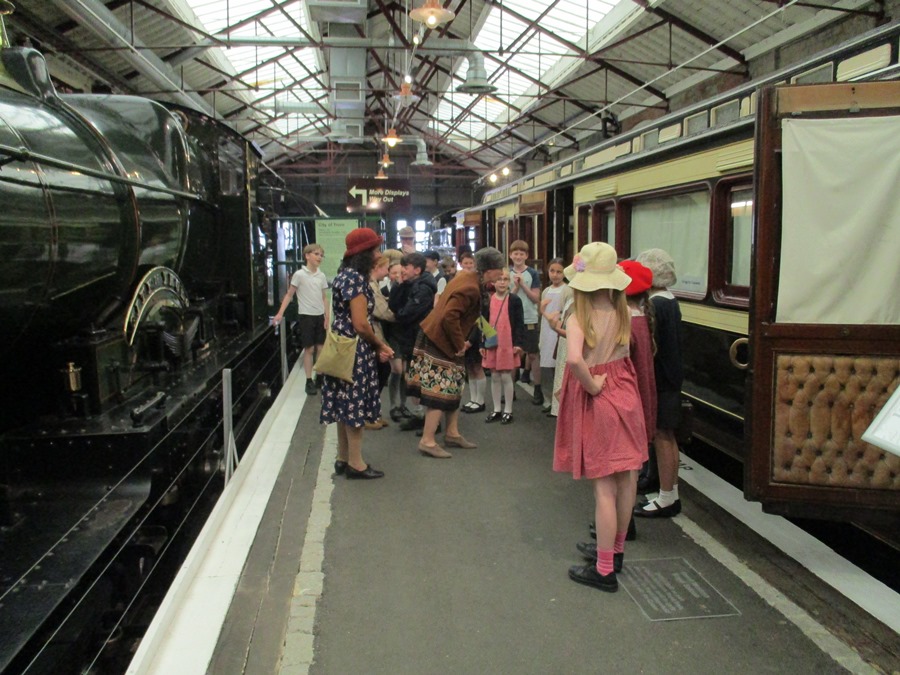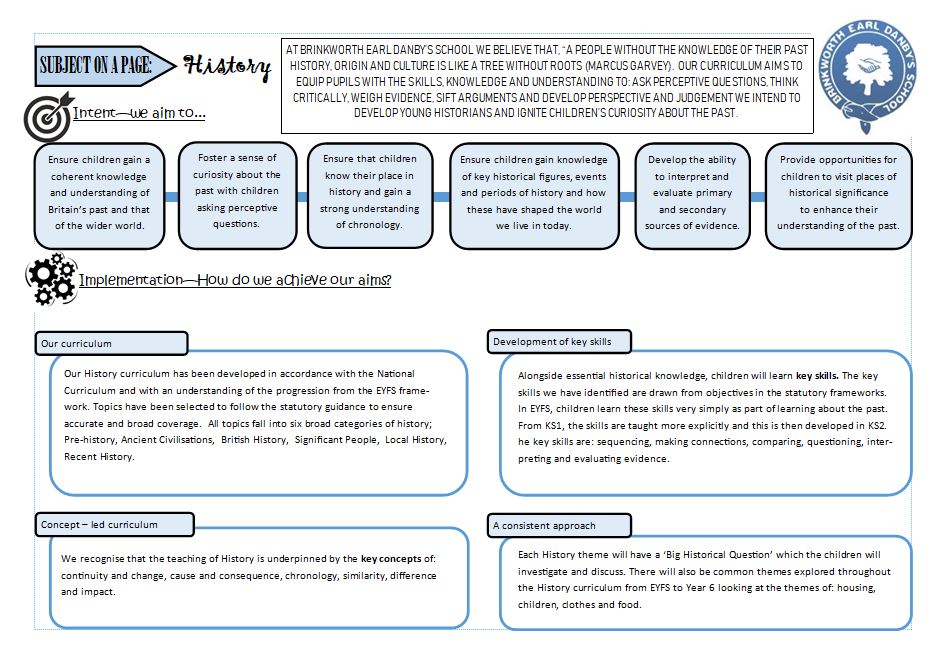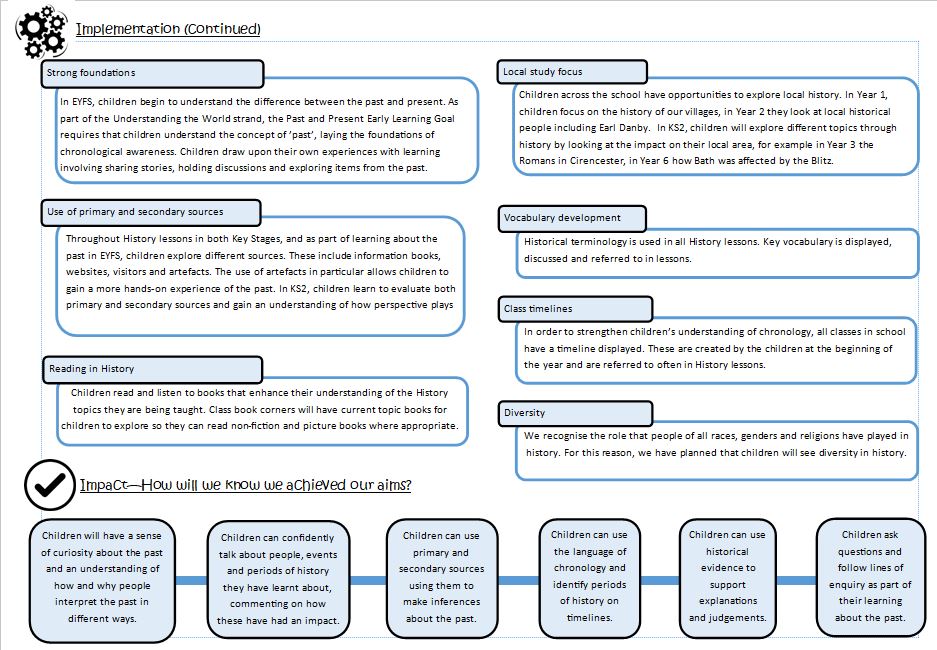|
|
Term One
|
Term Two
|
Term Three
|
Term Four
|
Term Five
|
Term Six
|
|
FS
|
All About Me Focusing on personal timelines, families, local communities.
All around the world Looking at historic elements of celebrations, for example Diwali, Guy Fawkes, and Remembrance Day.
|
How things have changed Looking at old and new buildings/structures, timelines, materials used in the past and new materials e.g plastic pollution and dinosaurs.
All creatures great and small David Attenborough’s biography.
|
Once upon a time
A focus on traditional stories, fables.
Journeys
How has transport evolved through time?
|
|
Y1
|
How am I making History -Memory Box?
- A timeline shows the order events in the past happened.
- Memories are events in our past.
- We celebrate the special events of Christmas, Easter and birthdays with special food and presents.
- Describing simple changes.
- Children could play in the street because there weren’t many cars. They were not allowed to play in the house as much as today. They could visit friends without an adult accompanying them.
|
How have Toys changed?
- Past & Present.
- Parents and grandparents used to play with toy cars and dolls just like we do today. What is a memory?
- Toys 100 years ago did not contain electronics and were not made from plastic as these had not yet been invented.
- Toys from the past are now worn. Toys would more likely have been made from wood or metal.
- They would not have any plastic parts and be made from mohair. Today they use synthetic materials.
|
How have explorers changed the world?
- A person who travels to different places to find out more about them.
- Explorers have travelled long distances to hot and cold places.
- Christopher Columbus was an explorer who accidently discovered America.
- Matthew Henson travelled in freezing conditions using a sled pulled by dogs.
- Ships are used less and are powered. Aeroplanes help travel nowadays. We have better clothing for different conditions.
|
|
Y2
|
How was Malmesbury different in the past? A Walk through our local History
- A timeline is a line to show the order of important events in the past.
- Memories are events in our past.
- A century ago there were few cars. All shopping had to be bought from the high street.
- The Abbey was built in the 12th century. Shopping can be bought online today and not just on the high street.
- There are similarities & differences between Malmesbury now & in the past.
|
The Great Fire of London
- The Great Fire of London happened in the summer of 1666 – almost 400 years ago.
- Samuel Pepys lived through the Great Fire of London and wrote a diary which tells us what happened.
- To know that the fire started in a bakery and the following main events which happened over the 5 days.
- Most buildings were made of wood and were built very close together. Fire fighters had to get water from the river to put the fire out.
- Only 10 people died in the Great Fire. 80,000 people were left homeless.
Christopher Wren planned how to rebuild the city.
|
How did we learn to fly?
- The Wright brothers were the inventors of the first engine-powered aeroplane.
- Orville piloted the first flight on December 17th 1903.
- Bessy Coleman was the first woman of colour to get an international pilot’s license.
- Amelia Earhart was the first woman to fly solo across the Atlantic Ocean.
- The moon landing was special because it was the first time humans had walked on the Moon.
|
|
Y3
|
What have the Romans done for us?
- The Roman empire covered a huge area over Africa and Asia. Romans had one of the most organised and skilful armies.
- Romans invaded Britain for a range of British resources (gold, iron and tin) and to make Britain part of the Roman empire.
- Romans built roads, houses, amphitheatre and temples. Cirencester once vied with London to be the capital of Britain.
- Roman legacy includes roads, drainage, sewage systems and education.
- Romans left England because they needed soldiers back in Rome to defend themselves.
|
Would you prefer to live in the Stone Age, Bronze Age or Iron Age?
- Prehistory was the beginning of the history of mankind.
- Skara Brae teaches us about how people lived in the Stone Age.
- Historians believe that the Amesbury Archer was a trader who bought pottery and copper from mainland Europe to Britain.
- The introduction of bronze transformed lives in Britain.
- Trading by exchanging increased and coins were introduced.
|
What did the Ancient Egyptians believe?
- Know ancient Egyptians lived in Egypt between 2600BC and 100AD
- The ancient Egyptians believed in multiple gods and goddesses.
- Egyptians built pyramids to store the bodies of their pharaohs, in preparation for the afterlife.
- Egyptians believed the soul and body reunited in the afterlife, so the body needed to be preserved in the best possible conditions.
- Egyptians believed in the afterlife and followed a ceremony to ensure people would reach the afterlife.
|
|
Y4
|
What impact did the Railways have on Britain?
- First steam locomotive was used in 1804. George Stephenson pioneered rail transport and the development of the first passenger railways.
- Steam engines were a reliable form of transport and made travel and trade quicker and easier.
- Railway development linked towns together such as London and Swindon and reduced travel time.
- Brunel designed famous bridges, tunnels and railways locally. Great Western Railway was established in 1833.
- Swindon was a small Victorian market town that grew with the development of the railway.
- 1840 Swindon became the engine shed and repair shop for GWR.
|
How hard was it to invade and settle in Britain: Anglo Saxons
- Anglo-Saxons were a group of people who invaded England and the Scots were a group who invaded Scotland.
- Anglo-Saxons settled in Britain by building their own homes out of natural materials including wood, wattle and daub.
- Sutton Hoo tells us Anglo-Saxons were skilled craftsmen and traded objects overseas with other countries.
- Christianity arrived in Britain because of the Christian missionaries who came over from Rome to persuade people to convert.
- King Alfred the Great can be seen as great as he successfully defended his kingdom, Wessex, against the Vikings.
|
What did the Greeks ever do for us?
- Greece us an island in the Mediterranean Sea. Ancient Greece was in the time period 700-480BC.
- Ancient Greeks believed that an extended family of 12 gods and goddesses controlled their lives. Mount Olympus was the home of the gods.
- Greece was governed as city states. Athens and Sparta were two of the biggest.
- Athenian democracy consisted of three parts: the assembly; the council or ‘boule’; and the courts.
- The Ancient Greeks studied philosophy (asking questions about human existence). Philosophers such as Plato, Pythagoras, Socrates and Aristotle did not accept that mythology, gods and goddesses explained human existence or made sense of the world.
|
|
Y5
|
What was life like in Bath during the Victorian times?
- Queen Victoria ruled 1837-1901 spanning the length of the Victorian era.
- Industrial revolution happened during Queen Victoria’s reign. Many new things were invented eg. Railways, radio, lightbulbs, Penny Black stamp.
- Bath was important to the Victorians as a spa town. Isambard Kingdom Brunel built Bath railway station.
- Children’s lives improved due to laws introduced to protect children.
- Victorian legacy of Victorian inventions was clean sanitation, railways.
|
Were the Vikings raiders, traders or settlers?
- Vikings came to raid and take valuable items from monasteries as well as to settle and farm peacefully as their homeland was not fertile.
- Primary sources are first-hand evidence from someone at that time whereas secondary is second-hand information from other researchers.
- Vikings travelled around using longboats.
- Anglo-Saxons saw the Vikings as raiders but others saw them as traders, depending on the source’s perspective.
- Eric Bloodaxe losing York allowed the Anglo-Saxons to control the whole of England.
|
How did the Mayan civilisation compare to the Anglo Saxons?
- Mayans lived in Mexico, Belize and Guatemala
- Mayans were resilient, skilled farmers, engineers and hunters.
- Both houses were rectangular in shape however Mayans had separate areas in the house for sleeping, living and eating
- The Mayans believed the six deities were the ones who created the Earth.
- The great plaza was on the main street in which important buildings were located.
|
|
Y6
|
What impact did the Blitz have on people’s lives in Bath?
- Germany lost WW1 and was made to take responsibility. Germany was forced to lose some of its land, disarm and pay large fines.
- Germany wanted to invade Britain. Battle of Britain – took place form 10th July -31st October 1940, successful defence by RAF, Germany realised it would not gain control of British airspace.
- The evacuation took place in stages. In September 1939, when war was declared, 1.5 million evacuees were sent to live in safer places.
- Anti-invasion defences were put in eg. air raid/Morrison shelters. The Blitz destroyed many homes, schools and infrastructure.
- The Blitz lasted 8 months 5 days. It took several years for evacuees to return and for infrastructure to be rebuilt.
|
What was life like in Tudor England?
- Henry VIII was a person of authority and was rich.
- Anne Boleyn was executed because she did not give birth to a male heir.
- Henry VIII has 6 wives altogether mainly because he required a male heir.
- Royal Progress (tours) were an opportunity for Elizabeth to project a positive image throughout the country. Each city was thoroughly cleaned and lanterns were hung out for the royal progress.
- Some Tudor families had 6 rooms and most poor families lived in only one room.
|
Unheard histories: Who should feature on a £10 note?
- Winston Churchill features on a bank note because he is a significant person who was famous for his speeches.
- Alfred the Great defeated the Vikings. Elizabeth I gave England stability after a turbulent year.
- Ellen Wilkinson was the first woman to become education minister.
- Betty Boothroyd was the first woman to become Speaker of the House of Common
- Mary Seacole nursed injured soldiers on the front line.
- Lily Parr inspired girls and women to play football. Betty Snowball helped popularise cricket.
|



